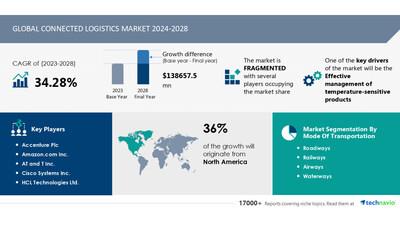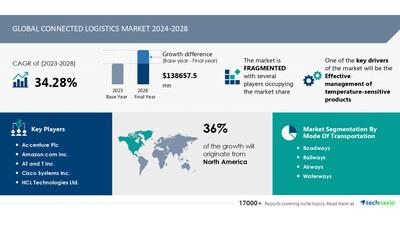
Connected Logistics Market Size Is Set To Grow By USD 138.65 Billion From 2024-2028, Effective Management Of Temperature-Sensitive Products Boost The Market, Technavio
| Connected Logistics Market Scope |
|
| Report Coverage |
Details |
| Base year |
2023 |
| Historic period |
2018 - 2022 |
| Forecast period |
2024-2028 |
| Growth momentum & CAGR |
Accelerate at a CAGR of 34.28% |
| Market growth 2024-2028 |
USD 138657.5 million |
| Market structure |
Fragmented |
| YoY growth 2022-2023 (%) |
25.64 |
| Regional analysis |
North America, Europe, APAC, South America, and Middle East and Africa |
| Performing market contribution |
North America at 36% |
| Key countries |
US, Germany, UK, China, and India |
| Key companies profiled |
Accenture Plc, Amazon Inc., AT and T Inc., Cisco Systems Inc., HCL Technologies Ltd., Huawei Technologies Co. Ltd., Infosys Ltd., Intel Corp., International Business Machines Corp., Microsoft Corp., Nokia Corp., Oracle Corp., ORBCOMM Inc., PTC Inc., Qualcomm Inc., Samsung Electronics Co. Ltd., SAP SE, Siemens AG, Tata Consultancy Services Ltd., and Thales Group |
Market Driver
The Connected Logistics Market is experiencing significant growth due to the increasing adoption of Internet of Things (IoT) in Supply Chain Management (SCM) systems. IoT technologies enable real-time tracking of shipments, gaining popularity in industries like manufacturing, healthcare, and transportation. IoT devices and sensors installed in storage facilities and containers transmit data to SCM teams, providing crucial information on product conditions and delivery status. Perishable goods, such as vaccines, require specific temperature ranges to avoid damage. IoT can detect and control technical faults in refrigeration systems, preventing potential damage. With the increasing number of IoT devices, managing and maintaining data becomes challenging. IoT solutions help logistics firms capture and analyze data from these devices using statistical modeling techniques. RFID, sensors, barcodes, and GPS are among the technologies used to monitor and manage physical assets efficiently in transportation and logistics. Companies like Tech Mahindra and HCL Technologies offer IoT solutions for cold storage management, allowing teams to track and monitor the movement of cold storage containers and carriers. By 2026, the number of smart connected devices is projected to reach 47 billion, underscoring the importance of IoT solutions for managing and analyzing data.
The Connected Logistics Market is experiencing significant growth as businesses embrace advanced technologies to streamline their logistical operations. Cloud platforms and the Internet of Things (IoT) are driving innovation in areas like order processing, financial transactions, shipping, warehousing, and transportation. Value-added logistics services are becoming increasingly important for online shopping and retail goods, with linked logistics systems ensuring interoperability between different systems. Cutting-edge technologies like intelligent transportation solutions, fleet telematics, and cellular IoT connectivity offer real-time transportation visibility, enabling route planning, disaster preparedness, and efficient use of resources. Autonomous logistics trucks and LoRa sensors are revolutionizing the transportation sector, while RFID tags, sensors, communication devices, and tracking devices enhance warehouse and fleet management. Governments are also playing a role in shaping the market through national logistics policies, with railways and roadways being key transportation modes. The focus on reducing frictional resistance and increasing carrying capacity is a priority for retail and e-commerce businesses, making managed services, consulting, and analytics solutions essential for optimizing logistical operations. Last-mile delivery and the role of logistics 4.0 in the retail and e-commerce sectors are also major trends to watch.
Discover 360° analysis of this market. For complete information, schedule your consultation -
Book Here!
Market
Challenges
-
The connected logistics market's growth may be hindered by technical issues, which can disrupt business operations. Connected logistics systems rely on digital logger solutions for continuous monitoring, but manual processes and human intervention can hinder real-time data transmission. These inefficiencies can lead to decreased client satisfaction and potential loss of business for vendors like Microsoft Corp. And Oracle Corp. Automation and elimination of manual processes are crucial for seamless connected logistics implementation. The presence of technical glitches poses a significant challenge to the market's expansion during the forecast period.
The Connected Logistics Market is experiencing significant growth due to the integration of smart devices, Bluetooth technology, and internet connectivity. Logistic operational effectiveness is improved through real-time tracking of logistics, enhancing worker safety and reducing supply chain disruptions. Logistic providers leverage electronic data and app-based interfaces for workload planning and inventory tracking. E-commerce platforms and tracking tools facilitate end-to-end delivery tracking, while cloud integration streamlines data access. Challenges include ensuring accuracy with automated scanning, managing transportation modes like cargo ships, aircraft, trucks, and transport vehicles, and addressing labour and raw material concerns. Real-time infographics provide valuable insights into transportation modes, fuel consumption, and government programs. Rail freight and trade are also impacted by these trends, requiring continuous adaptation to remain competitive.
For more insights on driver and challenges
-
Request a
sample report!
Segment Overview
This connected logistics market report extensively covers market segmentation by
-
1.1 Roadways
1.2 Railways
1.3 Airways
1.4 Waterways
-
2.1 Software services
2.2 IT services
2.3 Hardware services
-
3.1 North America
3.2 Europe
3.3 APAC
3.4 South America
3.5 Middle East and Africa
1.1
Roadways-
For more information on market segmentation with geographical analysis including forecast (2024-2028) and historic data (2017-2021) - Download a Sample Report
Research Analysis
The Connected Logistics Market is revolutionizing traditional supply chain management by integrating advanced technologies such as cloud platforms, Internet of Things (IoT), and intelligent transportation solutions. These innovations enable real-time order processing, financial transactions, and tracking of logistical operations. Connected logistics systems facilitate seamless communication between supply chain partners through linked logistics systems, ensuring interoperability and accessibility. IoT sensors and connected logistics hardware provide valuable data on shipping, warehousing, and transportation, enabling value-added logistics services and optimizing inventory management. Logistics 4.0, a key component of Industry 4.0, integrates cutting-edge technologies like Bluetooth, Network, and Communication systems to create a secure, efficient, and intelligent logistics network. Autonomous logistics trucks and intelligent transportation systems further enhance the market's capabilities, ensuring safety and reducing operational costs. Cloud-based technology plays a crucial role in connected logistics by enabling real-time data access and analysis, improving overall supply chain performance and customer satisfaction. The market's growth is driven by the increasing popularity of online shopping and the need for faster, more efficient logistics solutions.
Market Research Overview
Connected logistics is revolutionizing traditional logistical operations by integrating cloud platforms, Internet of Things (IoT) technologies, and real-time communication systems. Order processing, financial transactions, shipping, warehousing, and transportation are becoming more efficient and interconnected through linked logistics systems. Online shopping and retail goods require last-mile delivery solutions, while intelligent transportation solutions offer route planning, transportation visibility, and real-time position tracking. Connected logistics hardware includes LoRa and cellular IoT connectivity, fleet telematics, RFID tags, sensors, communication devices, and tracking devices. Value-added logistics services provide managed services, consulting, and transportation mode options, including roadways, railway, and interconnected communication systems. Logistics 4.0 focuses on logistic operational effectiveness, worker safety, and supply chain disruption prevention. Intelligent transportation systems use safety features like autonomous logistics trucks and IoT sensors for disaster preparedness. Connected logistics also offers interoperability between linked devices, analytics solutions, and cloud integration for retail and e-commerce, automotive, aerospace and defense, healthcare, energy, electronics and semiconductors, and other industries. Governments are implementing national logistics policies to improve transportation sector infrastructure and reduce frictional resistance. Connected logistics offers accessibility, security, and safety benefits, making it a crucial aspect of modern business operations.
Table of Contents:
1 Executive Summary
2 Market Landscape
3 Market Sizing
4 Historic Market Size
5 Five Forces Analysis
6 Market Segmentation
-
Mode Of Transportation
-
Roadways
Railways
Airways
Waterways
-
Software Services
IT Services
Hardware Services
-
North America
Europe
APAC
South America
Middle East And Africa
7
Customer Landscape
8 Geographic Landscape
9 Drivers, Challenges, and Trends
10 Company Landscape
11 Company Analysis
12 Appendix
About Technavio
Technavio is a leading global technology research and advisory company. Their research and analysis focuses on emerging market trends and provides actionable insights to help businesses identify market opportunities and develop effective strategies to optimize their market positions.
With over 500 specialized analysts, Technavio's report library consists of more than 17,000 reports and counting, covering 800 technologies, spanning across 50 countries. Their client base consists of enterprises of all sizes, including more than 100 Fortune 500 companies. This growing client base relies on Technavio's comprehensive coverage, extensive research, and actionable market insights to identify opportunities in existing and potential markets and assess their competitive positions within changing market scenarios.
Contacts
Technavio Research
Jesse Maida
Media & Marketing Executive
US: +1 844 364 1100
UK: +44 203 893 3200
Email:
[email protected]
Website:
SOURCE Technavio

Legal Disclaimer:
MENAFN provides the
information “as is” without warranty of any kind. We do not accept
any responsibility or liability for the accuracy, content, images,
videos, licenses, completeness, legality, or reliability of the information
contained in this article. If you have any complaints or copyright
issues related to this article, kindly contact the provider above.


















Comments
No comment